Competitive Advantage Analysis Report: Amazon.com and Uber - BUS300
VerifiedAdded on 2020/03/04
|8
|1439
|56
Report
AI Summary
This report provides a comprehensive analysis of the competitive strategies employed by Amazon and Uber. It begins with an overview of Amazon, examining its e-commerce dominance, cost leadership strategy, customer-centric approach, and innovative business model, including its expansion into various services like Amazon Prime and Alexa. The report then shifts its focus to Uber, exploring its disruptive impact on the transportation industry, its innovative use of technology, and its business model that prioritizes high service standards and data analysis for strategic decision-making. The report highlights the key components of each company's business model, including warehousing, online operations, mobile applications, and driver management, while also considering the factors contributing to their sustained growth and market success. The report concludes by drawing parallels between the two companies' approaches to competitive advantage.
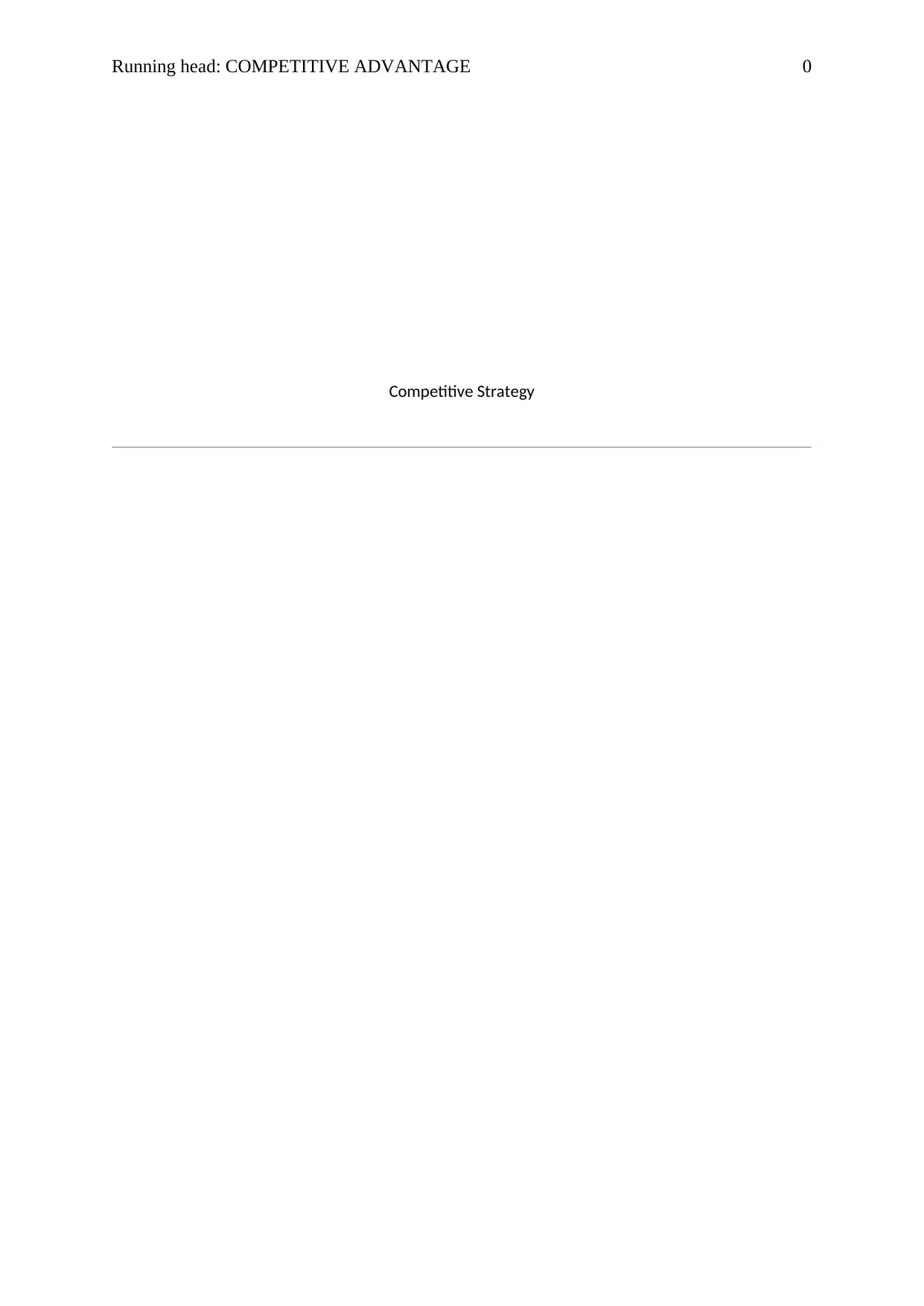
Running head: COMPETITIVE ADVANTAGE 0
Competitive Strategy
Competitive Strategy
Paraphrase This Document
Need a fresh take? Get an instant paraphrase of this document with our AI Paraphraser
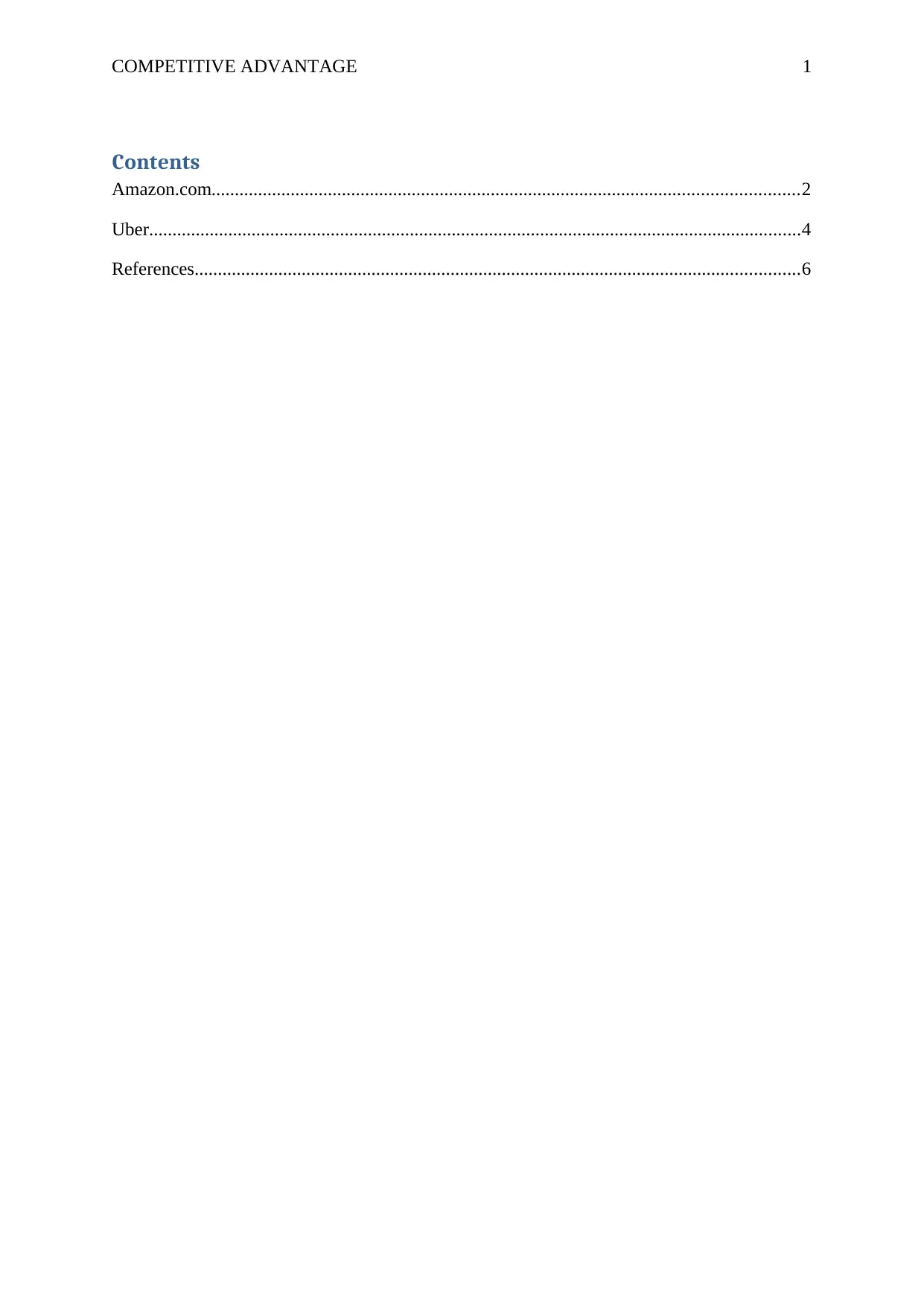
COMPETITIVE ADVANTAGE 1
Contents
Amazon.com..............................................................................................................................2
Uber............................................................................................................................................4
References..................................................................................................................................6
Contents
Amazon.com..............................................................................................................................2
Uber............................................................................................................................................4
References..................................................................................................................................6
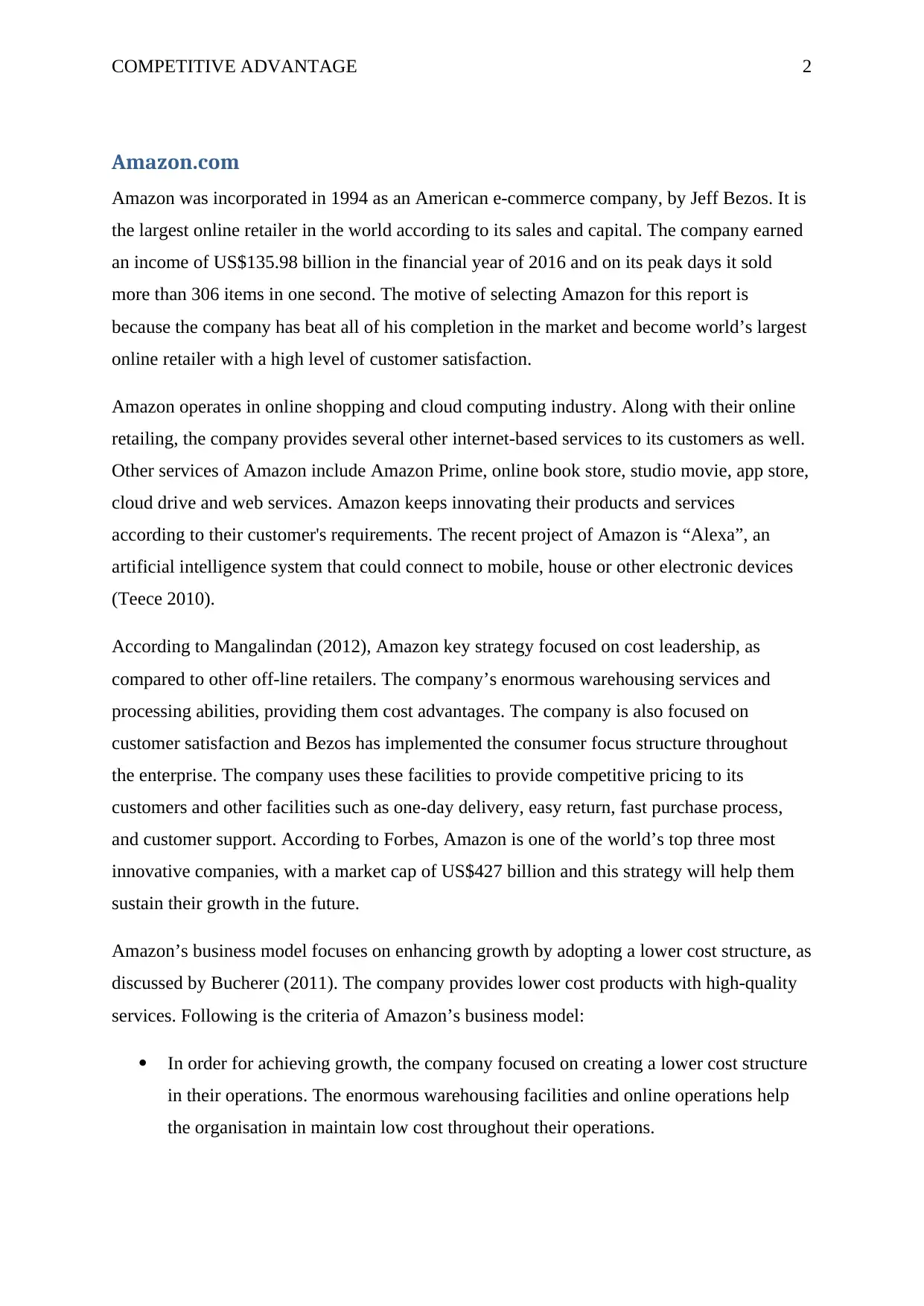
COMPETITIVE ADVANTAGE 2
Amazon.com
Amazon was incorporated in 1994 as an American e-commerce company, by Jeff Bezos. It is
the largest online retailer in the world according to its sales and capital. The company earned
an income of US$135.98 billion in the financial year of 2016 and on its peak days it sold
more than 306 items in one second. The motive of selecting Amazon for this report is
because the company has beat all of his completion in the market and become world’s largest
online retailer with a high level of customer satisfaction.
Amazon operates in online shopping and cloud computing industry. Along with their online
retailing, the company provides several other internet-based services to its customers as well.
Other services of Amazon include Amazon Prime, online book store, studio movie, app store,
cloud drive and web services. Amazon keeps innovating their products and services
according to their customer's requirements. The recent project of Amazon is “Alexa”, an
artificial intelligence system that could connect to mobile, house or other electronic devices
(Teece 2010).
According to Mangalindan (2012), Amazon key strategy focused on cost leadership, as
compared to other off-line retailers. The company’s enormous warehousing services and
processing abilities, providing them cost advantages. The company is also focused on
customer satisfaction and Bezos has implemented the consumer focus structure throughout
the enterprise. The company uses these facilities to provide competitive pricing to its
customers and other facilities such as one-day delivery, easy return, fast purchase process,
and customer support. According to Forbes, Amazon is one of the world’s top three most
innovative companies, with a market cap of US$427 billion and this strategy will help them
sustain their growth in the future.
Amazon’s business model focuses on enhancing growth by adopting a lower cost structure, as
discussed by Bucherer (2011). The company provides lower cost products with high-quality
services. Following is the criteria of Amazon’s business model:
In order for achieving growth, the company focused on creating a lower cost structure
in their operations. The enormous warehousing facilities and online operations help
the organisation in maintain low cost throughout their operations.
Amazon.com
Amazon was incorporated in 1994 as an American e-commerce company, by Jeff Bezos. It is
the largest online retailer in the world according to its sales and capital. The company earned
an income of US$135.98 billion in the financial year of 2016 and on its peak days it sold
more than 306 items in one second. The motive of selecting Amazon for this report is
because the company has beat all of his completion in the market and become world’s largest
online retailer with a high level of customer satisfaction.
Amazon operates in online shopping and cloud computing industry. Along with their online
retailing, the company provides several other internet-based services to its customers as well.
Other services of Amazon include Amazon Prime, online book store, studio movie, app store,
cloud drive and web services. Amazon keeps innovating their products and services
according to their customer's requirements. The recent project of Amazon is “Alexa”, an
artificial intelligence system that could connect to mobile, house or other electronic devices
(Teece 2010).
According to Mangalindan (2012), Amazon key strategy focused on cost leadership, as
compared to other off-line retailers. The company’s enormous warehousing services and
processing abilities, providing them cost advantages. The company is also focused on
customer satisfaction and Bezos has implemented the consumer focus structure throughout
the enterprise. The company uses these facilities to provide competitive pricing to its
customers and other facilities such as one-day delivery, easy return, fast purchase process,
and customer support. According to Forbes, Amazon is one of the world’s top three most
innovative companies, with a market cap of US$427 billion and this strategy will help them
sustain their growth in the future.
Amazon’s business model focuses on enhancing growth by adopting a lower cost structure, as
discussed by Bucherer (2011). The company provides lower cost products with high-quality
services. Following is the criteria of Amazon’s business model:
In order for achieving growth, the company focused on creating a lower cost structure
in their operations. The enormous warehousing facilities and online operations help
the organisation in maintain low cost throughout their operations.
⊘ This is a preview!⊘
Do you want full access?
Subscribe today to unlock all pages.

Trusted by 1+ million students worldwide
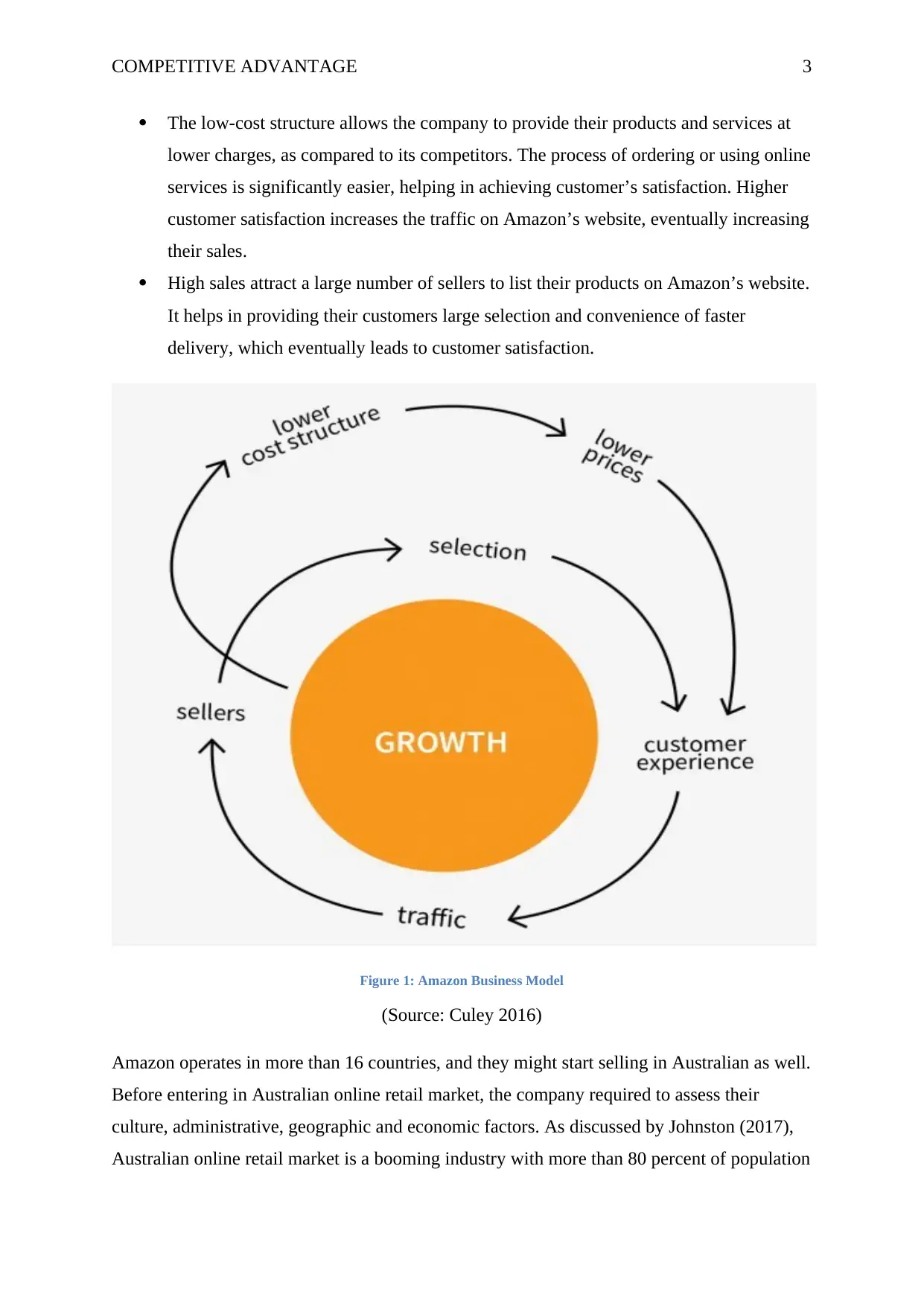
COMPETITIVE ADVANTAGE 3
The low-cost structure allows the company to provide their products and services at
lower charges, as compared to its competitors. The process of ordering or using online
services is significantly easier, helping in achieving customer’s satisfaction. Higher
customer satisfaction increases the traffic on Amazon’s website, eventually increasing
their sales.
High sales attract a large number of sellers to list their products on Amazon’s website.
It helps in providing their customers large selection and convenience of faster
delivery, which eventually leads to customer satisfaction.
Figure 1: Amazon Business Model
(Source: Culey 2016)
Amazon operates in more than 16 countries, and they might start selling in Australian as well.
Before entering in Australian online retail market, the company required to assess their
culture, administrative, geographic and economic factors. As discussed by Johnston (2017),
Australian online retail market is a booming industry with more than 80 percent of population
The low-cost structure allows the company to provide their products and services at
lower charges, as compared to its competitors. The process of ordering or using online
services is significantly easier, helping in achieving customer’s satisfaction. Higher
customer satisfaction increases the traffic on Amazon’s website, eventually increasing
their sales.
High sales attract a large number of sellers to list their products on Amazon’s website.
It helps in providing their customers large selection and convenience of faster
delivery, which eventually leads to customer satisfaction.
Figure 1: Amazon Business Model
(Source: Culey 2016)
Amazon operates in more than 16 countries, and they might start selling in Australian as well.
Before entering in Australian online retail market, the company required to assess their
culture, administrative, geographic and economic factors. As discussed by Johnston (2017),
Australian online retail market is a booming industry with more than 80 percent of population
Paraphrase This Document
Need a fresh take? Get an instant paraphrase of this document with our AI Paraphraser
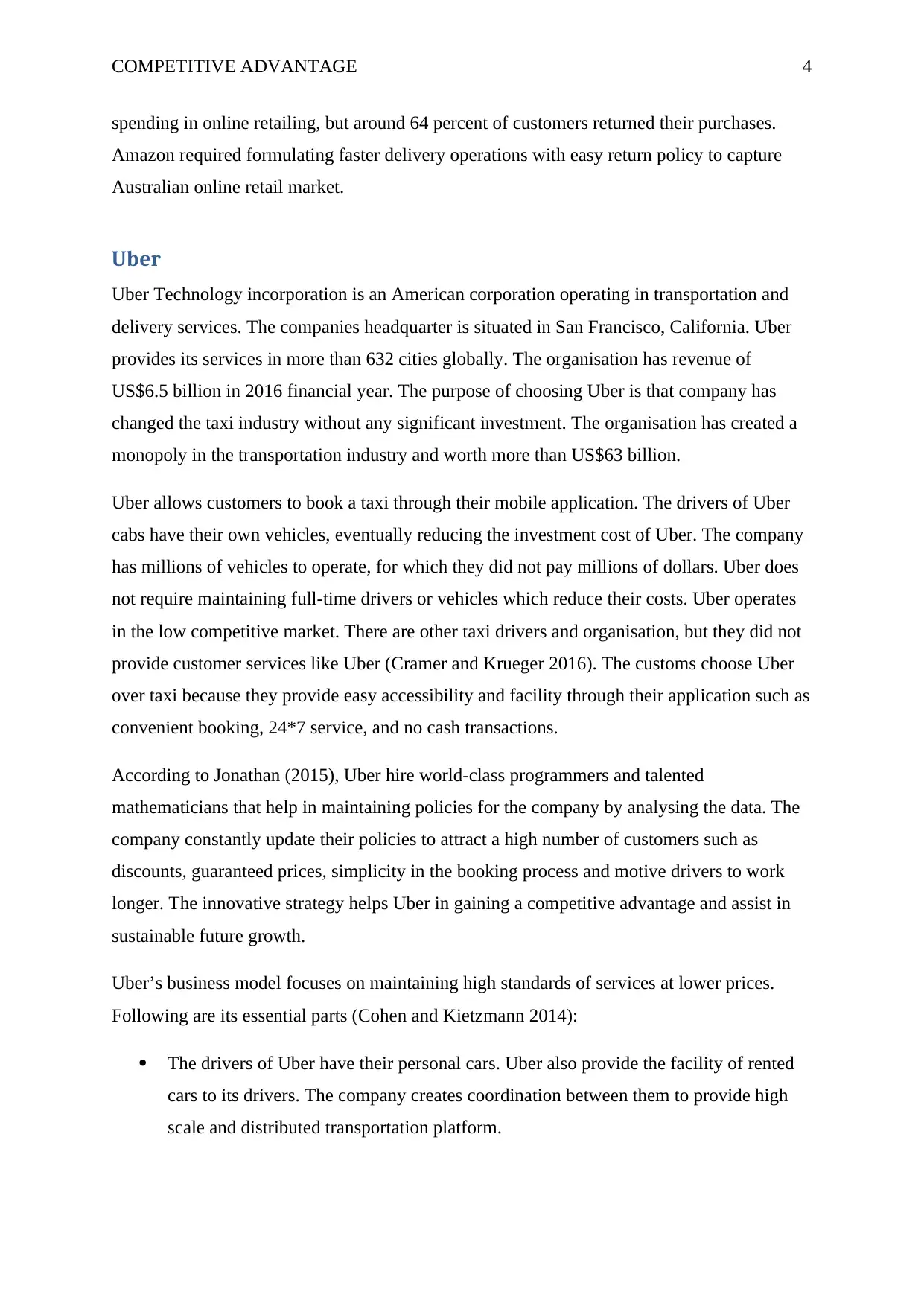
COMPETITIVE ADVANTAGE 4
spending in online retailing, but around 64 percent of customers returned their purchases.
Amazon required formulating faster delivery operations with easy return policy to capture
Australian online retail market.
Uber
Uber Technology incorporation is an American corporation operating in transportation and
delivery services. The companies headquarter is situated in San Francisco, California. Uber
provides its services in more than 632 cities globally. The organisation has revenue of
US$6.5 billion in 2016 financial year. The purpose of choosing Uber is that company has
changed the taxi industry without any significant investment. The organisation has created a
monopoly in the transportation industry and worth more than US$63 billion.
Uber allows customers to book a taxi through their mobile application. The drivers of Uber
cabs have their own vehicles, eventually reducing the investment cost of Uber. The company
has millions of vehicles to operate, for which they did not pay millions of dollars. Uber does
not require maintaining full-time drivers or vehicles which reduce their costs. Uber operates
in the low competitive market. There are other taxi drivers and organisation, but they did not
provide customer services like Uber (Cramer and Krueger 2016). The customs choose Uber
over taxi because they provide easy accessibility and facility through their application such as
convenient booking, 24*7 service, and no cash transactions.
According to Jonathan (2015), Uber hire world-class programmers and talented
mathematicians that help in maintaining policies for the company by analysing the data. The
company constantly update their policies to attract a high number of customers such as
discounts, guaranteed prices, simplicity in the booking process and motive drivers to work
longer. The innovative strategy helps Uber in gaining a competitive advantage and assist in
sustainable future growth.
Uber’s business model focuses on maintaining high standards of services at lower prices.
Following are its essential parts (Cohen and Kietzmann 2014):
The drivers of Uber have their personal cars. Uber also provide the facility of rented
cars to its drivers. The company creates coordination between them to provide high
scale and distributed transportation platform.
spending in online retailing, but around 64 percent of customers returned their purchases.
Amazon required formulating faster delivery operations with easy return policy to capture
Australian online retail market.
Uber
Uber Technology incorporation is an American corporation operating in transportation and
delivery services. The companies headquarter is situated in San Francisco, California. Uber
provides its services in more than 632 cities globally. The organisation has revenue of
US$6.5 billion in 2016 financial year. The purpose of choosing Uber is that company has
changed the taxi industry without any significant investment. The organisation has created a
monopoly in the transportation industry and worth more than US$63 billion.
Uber allows customers to book a taxi through their mobile application. The drivers of Uber
cabs have their own vehicles, eventually reducing the investment cost of Uber. The company
has millions of vehicles to operate, for which they did not pay millions of dollars. Uber does
not require maintaining full-time drivers or vehicles which reduce their costs. Uber operates
in the low competitive market. There are other taxi drivers and organisation, but they did not
provide customer services like Uber (Cramer and Krueger 2016). The customs choose Uber
over taxi because they provide easy accessibility and facility through their application such as
convenient booking, 24*7 service, and no cash transactions.
According to Jonathan (2015), Uber hire world-class programmers and talented
mathematicians that help in maintaining policies for the company by analysing the data. The
company constantly update their policies to attract a high number of customers such as
discounts, guaranteed prices, simplicity in the booking process and motive drivers to work
longer. The innovative strategy helps Uber in gaining a competitive advantage and assist in
sustainable future growth.
Uber’s business model focuses on maintaining high standards of services at lower prices.
Following are its essential parts (Cohen and Kietzmann 2014):
The drivers of Uber have their personal cars. Uber also provide the facility of rented
cars to its drivers. The company creates coordination between them to provide high
scale and distributed transportation platform.
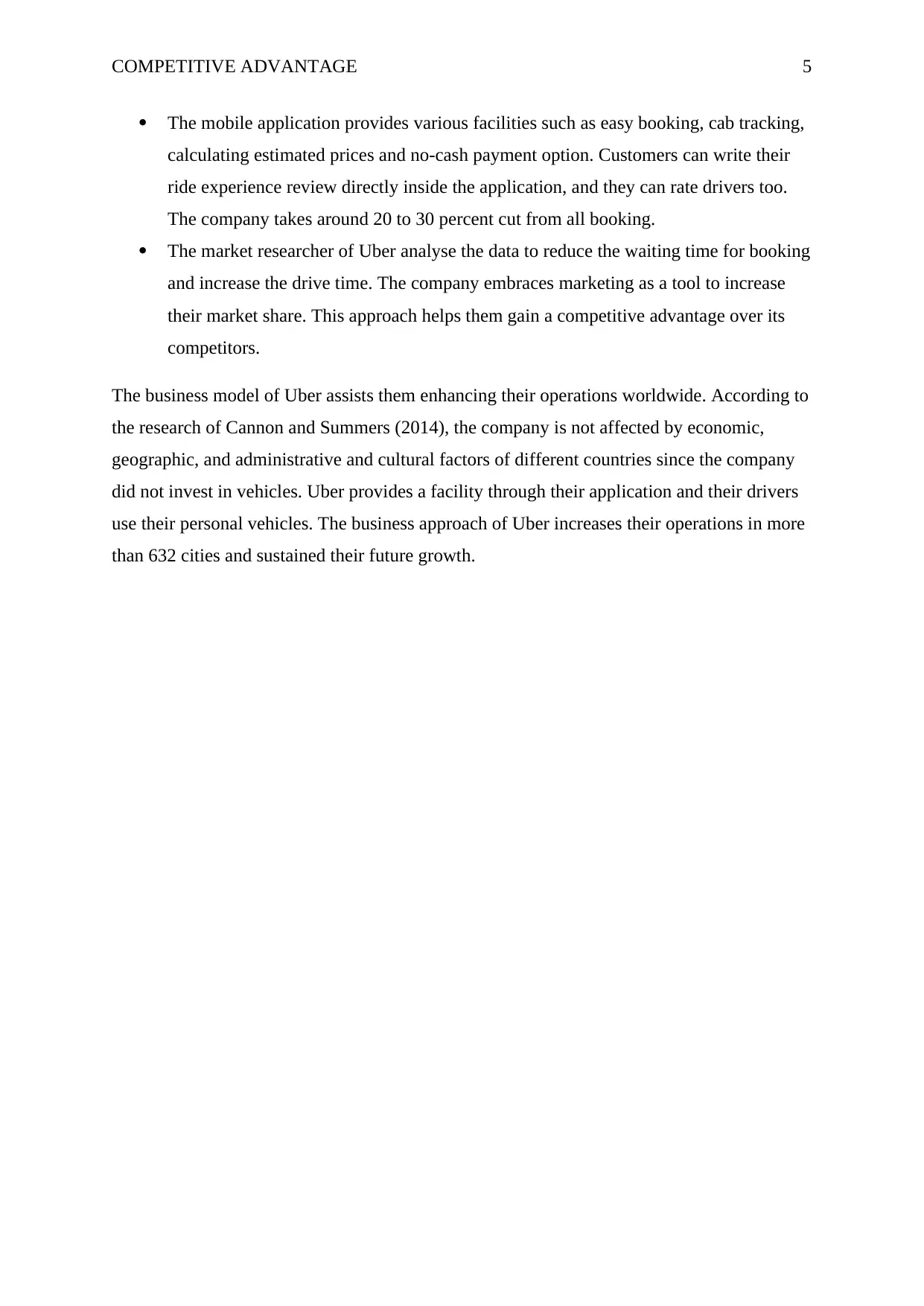
COMPETITIVE ADVANTAGE 5
The mobile application provides various facilities such as easy booking, cab tracking,
calculating estimated prices and no-cash payment option. Customers can write their
ride experience review directly inside the application, and they can rate drivers too.
The company takes around 20 to 30 percent cut from all booking.
The market researcher of Uber analyse the data to reduce the waiting time for booking
and increase the drive time. The company embraces marketing as a tool to increase
their market share. This approach helps them gain a competitive advantage over its
competitors.
The business model of Uber assists them enhancing their operations worldwide. According to
the research of Cannon and Summers (2014), the company is not affected by economic,
geographic, and administrative and cultural factors of different countries since the company
did not invest in vehicles. Uber provides a facility through their application and their drivers
use their personal vehicles. The business approach of Uber increases their operations in more
than 632 cities and sustained their future growth.
The mobile application provides various facilities such as easy booking, cab tracking,
calculating estimated prices and no-cash payment option. Customers can write their
ride experience review directly inside the application, and they can rate drivers too.
The company takes around 20 to 30 percent cut from all booking.
The market researcher of Uber analyse the data to reduce the waiting time for booking
and increase the drive time. The company embraces marketing as a tool to increase
their market share. This approach helps them gain a competitive advantage over its
competitors.
The business model of Uber assists them enhancing their operations worldwide. According to
the research of Cannon and Summers (2014), the company is not affected by economic,
geographic, and administrative and cultural factors of different countries since the company
did not invest in vehicles. Uber provides a facility through their application and their drivers
use their personal vehicles. The business approach of Uber increases their operations in more
than 632 cities and sustained their future growth.
⊘ This is a preview!⊘
Do you want full access?
Subscribe today to unlock all pages.

Trusted by 1+ million students worldwide
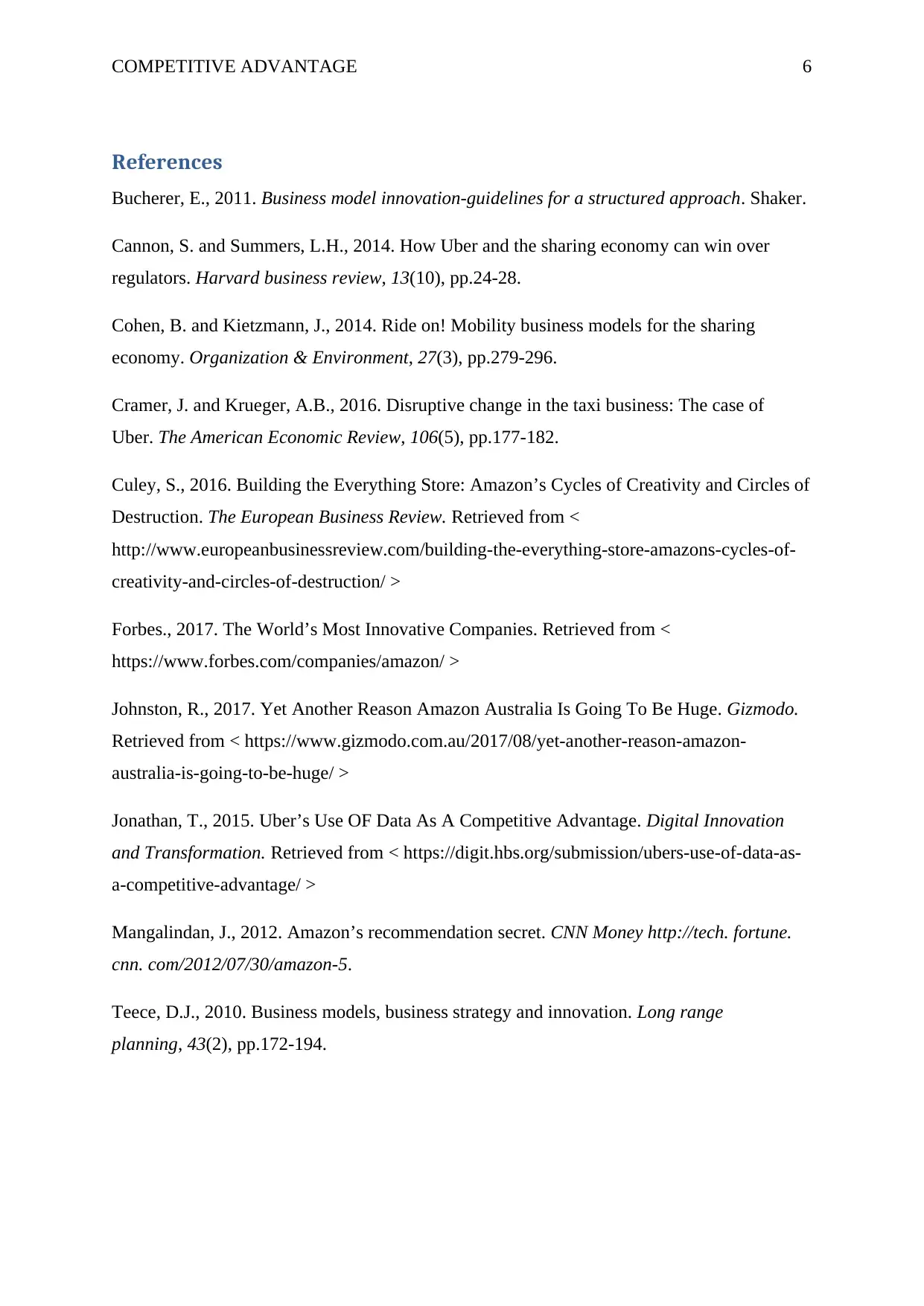
COMPETITIVE ADVANTAGE 6
References
Bucherer, E., 2011. Business model innovation-guidelines for a structured approach. Shaker.
Cannon, S. and Summers, L.H., 2014. How Uber and the sharing economy can win over
regulators. Harvard business review, 13(10), pp.24-28.
Cohen, B. and Kietzmann, J., 2014. Ride on! Mobility business models for the sharing
economy. Organization & Environment, 27(3), pp.279-296.
Cramer, J. and Krueger, A.B., 2016. Disruptive change in the taxi business: The case of
Uber. The American Economic Review, 106(5), pp.177-182.
Culey, S., 2016. Building the Everything Store: Amazon’s Cycles of Creativity and Circles of
Destruction. The European Business Review. Retrieved from <
http://www.europeanbusinessreview.com/building-the-everything-store-amazons-cycles-of-
creativity-and-circles-of-destruction/ >
Forbes., 2017. The World’s Most Innovative Companies. Retrieved from <
https://www.forbes.com/companies/amazon/ >
Johnston, R., 2017. Yet Another Reason Amazon Australia Is Going To Be Huge. Gizmodo.
Retrieved from < https://www.gizmodo.com.au/2017/08/yet-another-reason-amazon-
australia-is-going-to-be-huge/ >
Jonathan, T., 2015. Uber’s Use OF Data As A Competitive Advantage. Digital Innovation
and Transformation. Retrieved from < https://digit.hbs.org/submission/ubers-use-of-data-as-
a-competitive-advantage/ >
Mangalindan, J., 2012. Amazon’s recommendation secret. CNN Money http://tech. fortune.
cnn. com/2012/07/30/amazon-5.
Teece, D.J., 2010. Business models, business strategy and innovation. Long range
planning, 43(2), pp.172-194.
References
Bucherer, E., 2011. Business model innovation-guidelines for a structured approach. Shaker.
Cannon, S. and Summers, L.H., 2014. How Uber and the sharing economy can win over
regulators. Harvard business review, 13(10), pp.24-28.
Cohen, B. and Kietzmann, J., 2014. Ride on! Mobility business models for the sharing
economy. Organization & Environment, 27(3), pp.279-296.
Cramer, J. and Krueger, A.B., 2016. Disruptive change in the taxi business: The case of
Uber. The American Economic Review, 106(5), pp.177-182.
Culey, S., 2016. Building the Everything Store: Amazon’s Cycles of Creativity and Circles of
Destruction. The European Business Review. Retrieved from <
http://www.europeanbusinessreview.com/building-the-everything-store-amazons-cycles-of-
creativity-and-circles-of-destruction/ >
Forbes., 2017. The World’s Most Innovative Companies. Retrieved from <
https://www.forbes.com/companies/amazon/ >
Johnston, R., 2017. Yet Another Reason Amazon Australia Is Going To Be Huge. Gizmodo.
Retrieved from < https://www.gizmodo.com.au/2017/08/yet-another-reason-amazon-
australia-is-going-to-be-huge/ >
Jonathan, T., 2015. Uber’s Use OF Data As A Competitive Advantage. Digital Innovation
and Transformation. Retrieved from < https://digit.hbs.org/submission/ubers-use-of-data-as-
a-competitive-advantage/ >
Mangalindan, J., 2012. Amazon’s recommendation secret. CNN Money http://tech. fortune.
cnn. com/2012/07/30/amazon-5.
Teece, D.J., 2010. Business models, business strategy and innovation. Long range
planning, 43(2), pp.172-194.
Paraphrase This Document
Need a fresh take? Get an instant paraphrase of this document with our AI Paraphraser

COMPETITIVE ADVANTAGE 7
1 out of 8
Related Documents
Your All-in-One AI-Powered Toolkit for Academic Success.
+13062052269
info@desklib.com
Available 24*7 on WhatsApp / Email
![[object Object]](/_next/static/media/star-bottom.7253800d.svg)
Unlock your academic potential
Copyright © 2020–2025 A2Z Services. All Rights Reserved. Developed and managed by ZUCOL.





